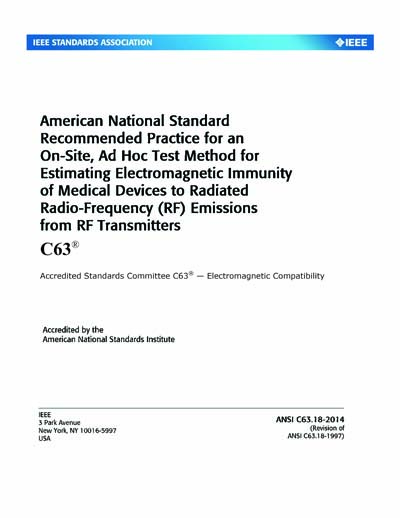Most recent
IEEE/ANSI C63.18-2014
American National Standard Recommended Practice for an On-Site, Ad Hoc Test Method for Estimating Electromagnetic Immunity of Medical Devices to Radiated Radio-Frequency (RF) Emissions from RF Transmitters
The purpose of this recommended practice is to provide an ad hoc test method to estimate the electromagnetic immunity of medical devices and help identify interference issues that might exist with critical medical devices as a result of emissions from RF transmitters increasingly used in health-care facilities, particularly by doctors, staff, patients, and visitors. RF transmitters include two-way radios, walkie-talkies, mobile phones, wireless-enabled laptop computers and similar devices, RFID readers, networked mp3 players, two-way pagers, wireless PDAs, and wireless medical devices. The test protocol is designed to be performed as follows: a) By clinical engineers, biomedical engineers, and other technical personnel b) In a way that is relatively rapid and practical c) In an area and with equipment that are commonly available d) To identify specific effects and thresholds (i.e., transmit power and distance) to provide the basic information needed to develop a mitigation action plan e) To generate test results that can be used in the formulation of policies and procedures for managing the use of RF transmitters within a health-care facility. A preferred method (5.6.2) and several alternative RF sources and methods (Annex C) for ad hoc testing are outlined in this recommended practice to allow flexibility with regard to the time, personnel, and resources available to perform the testing. As a result, these different options provide different levels of accuracy and comprehensiveness. The most appropriate ad hoc test strategy will depend on the needs and resources of the user of this recommended practice. This recommended practice also provides guidance for selection of the medical devices to be tested, operation of RF transmitters used as RF test sources, and assessment of test results. The preferred method for evaluation in most circumstances involves the use of the actual RF transmitter(s) (e.g., mobile phones and portable and mobile radios) as test sources to generate the same RF signals that would be encountered in the health-care facility. This approach also assumes that the end user has limited time and resources, a small number of critical medical devices to test, a limited space in which to perform the testing, and a single or a small number of specific RF transmitter signals to examine. In this preferred method, the RF transmitter is placed in a constantly transmitting state (i.e., test mode). The tests can be performed with or without an electric-field-strength (E-field) meter, although the use of an E-field meter is recommended. Another important function of this recommended practice is to define a consistent test protocol to allow results to be obtained and compared within and across institutions. Clinical and biomedical engineers have performed their own rudimentary (ad hoc) electromagnetic compatibility (EMC) testing using in-house methodology, RF transmitter sources, and medical devices. As a result, a comparison of the findings between health-care organizations might not be appropriate. To facilitate a comparison between health-care organizations, it is important that the recommendations herein are followed, deviations are kept to a minimum, and the testing is performed as consistently as possible. Policies and procedures for mitigation of electromagnetic interference (EMI)^2 in health-care facilities, including the use or restriction of specific RF transmitters within specific areas, often called an exclusion zone, should be based on objective information, including that obtained by the use of this test method. A common problem with exclusion zones is that they are difficult to enforce. With regard to purchase evaluation, confirming that medical devices conform to voluntary EMC immunity standards can provide some information, although many RF transmitters are able to exceed these immunity levels greatly when held close to a medical device.
Institute of Electrical and Electronics Engineers [ieee]

